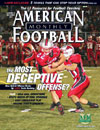AMERICAN FOOTBALL MONTHLY THE #1 RESOURCE FOR FOOTBALL COACHES
Article CategoriesAFM Magazine
|
Gaining the Pre- and Post-Snap AdvantageHow to gain leverage on defenses before and after snapping the ballby: Mike Kuchar © More from this issue It is commonly said that an offense has two distinct pre-snap advantages over any particular defense: one, they know the snap count and two, they know where the ball is going. Once the ball is snapped those advantages disappear, but there are other factors post-snap, such as movement and deception, to help leverage defenses. AFM talked to three of the more prominent coaches in the country: Dale Weiner of Catholic High School in Baton Rouge; Byron Hamilton of Foothill High School in California and Glenn Caruso of Macalester College. We asked them about some of the things they do offensively to put defenses in a disadvantage before and after the ball is snapped. PRE-SNAP READS Changing the Cadence Without question, one of the most under coached aspects of football is the cadence. How many times wi....The full article can only be seen by subscribers. Subscribe today!
|
|
|||||||
| HOME |
MAGAZINE |
SUBSCRIBE | ONLINE COLUMNISTS | COACHING VIDEOS |
Copyright 2026, AmericanFootballMonthly.com
All Rights Reserved





